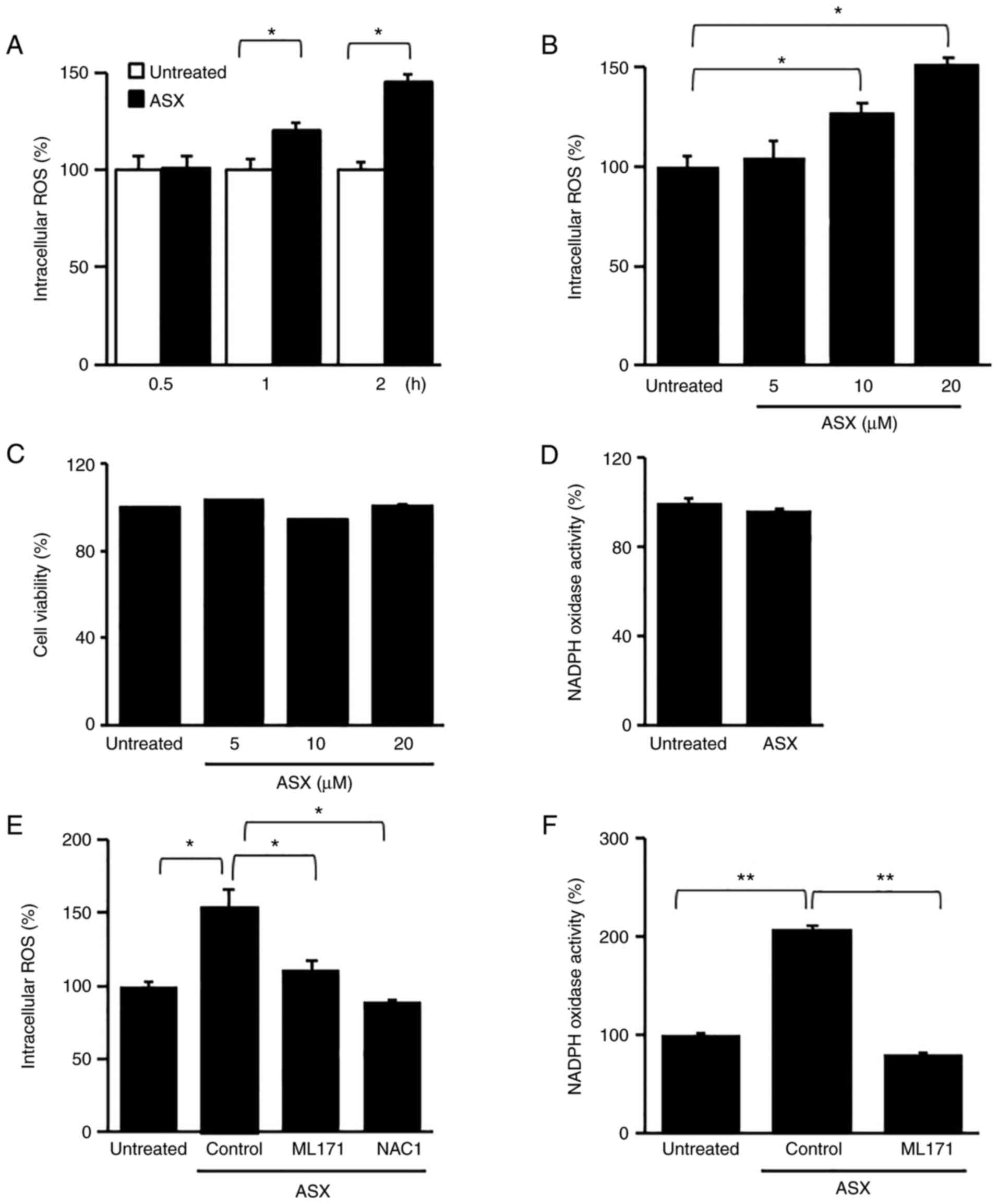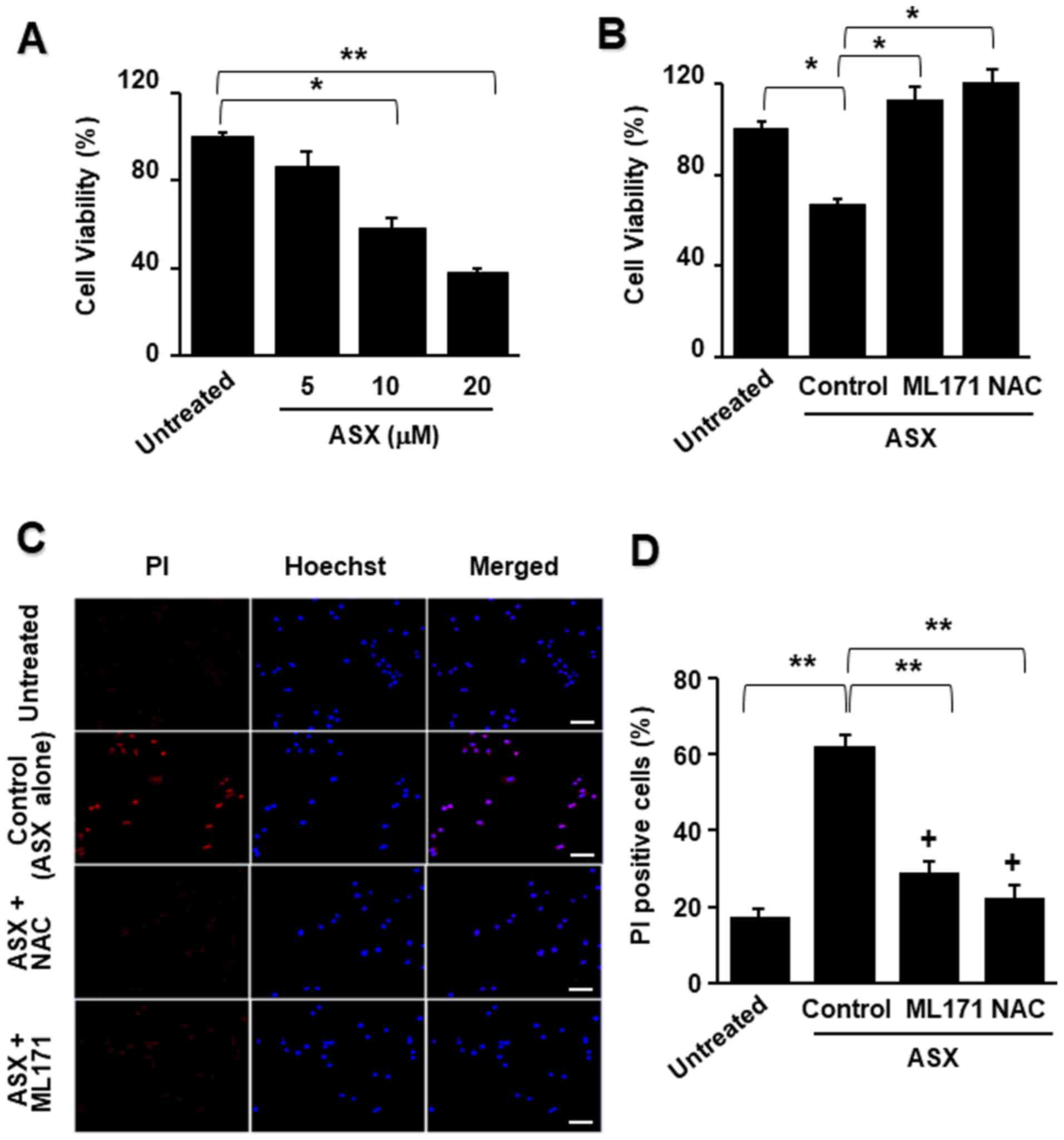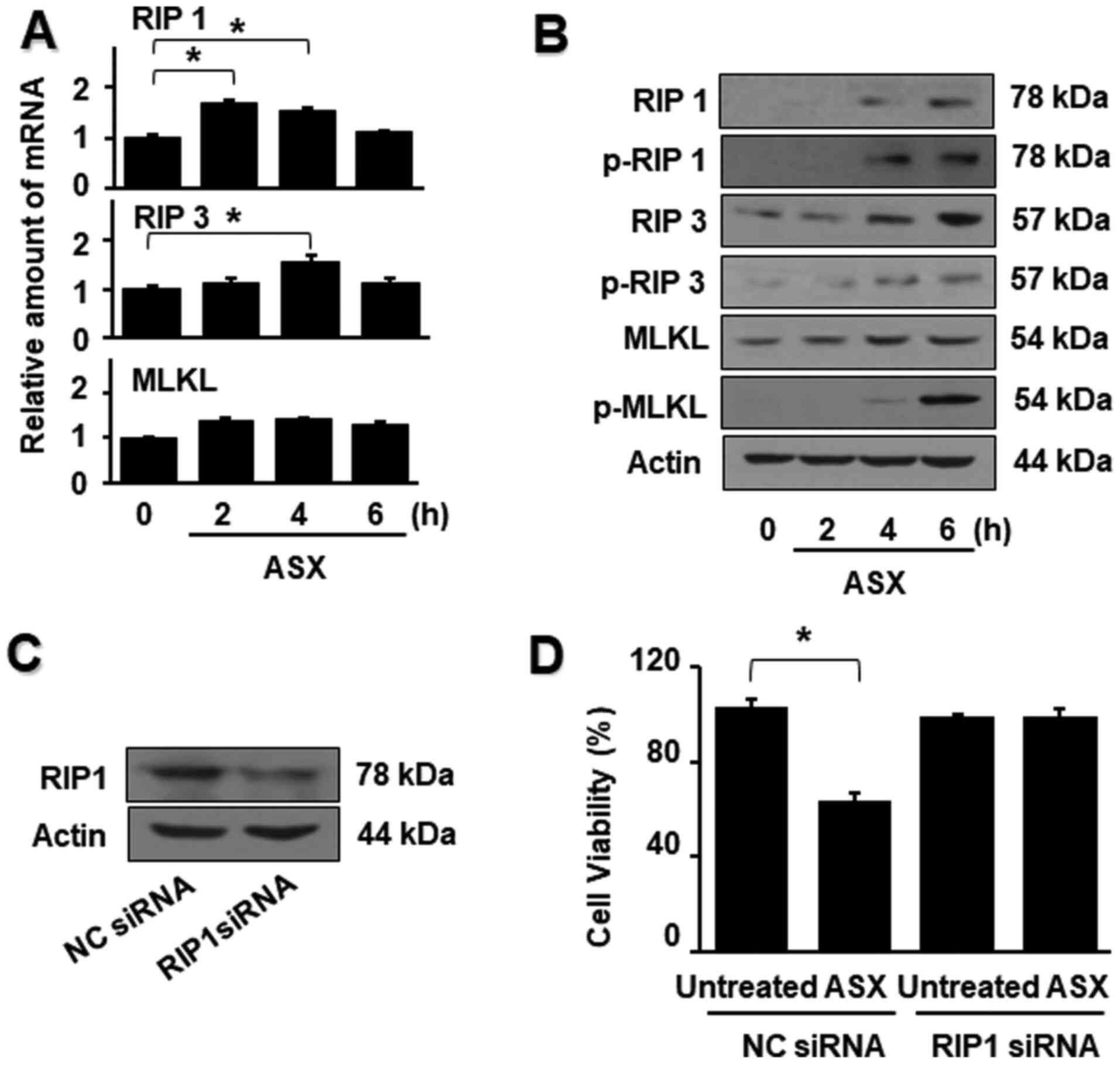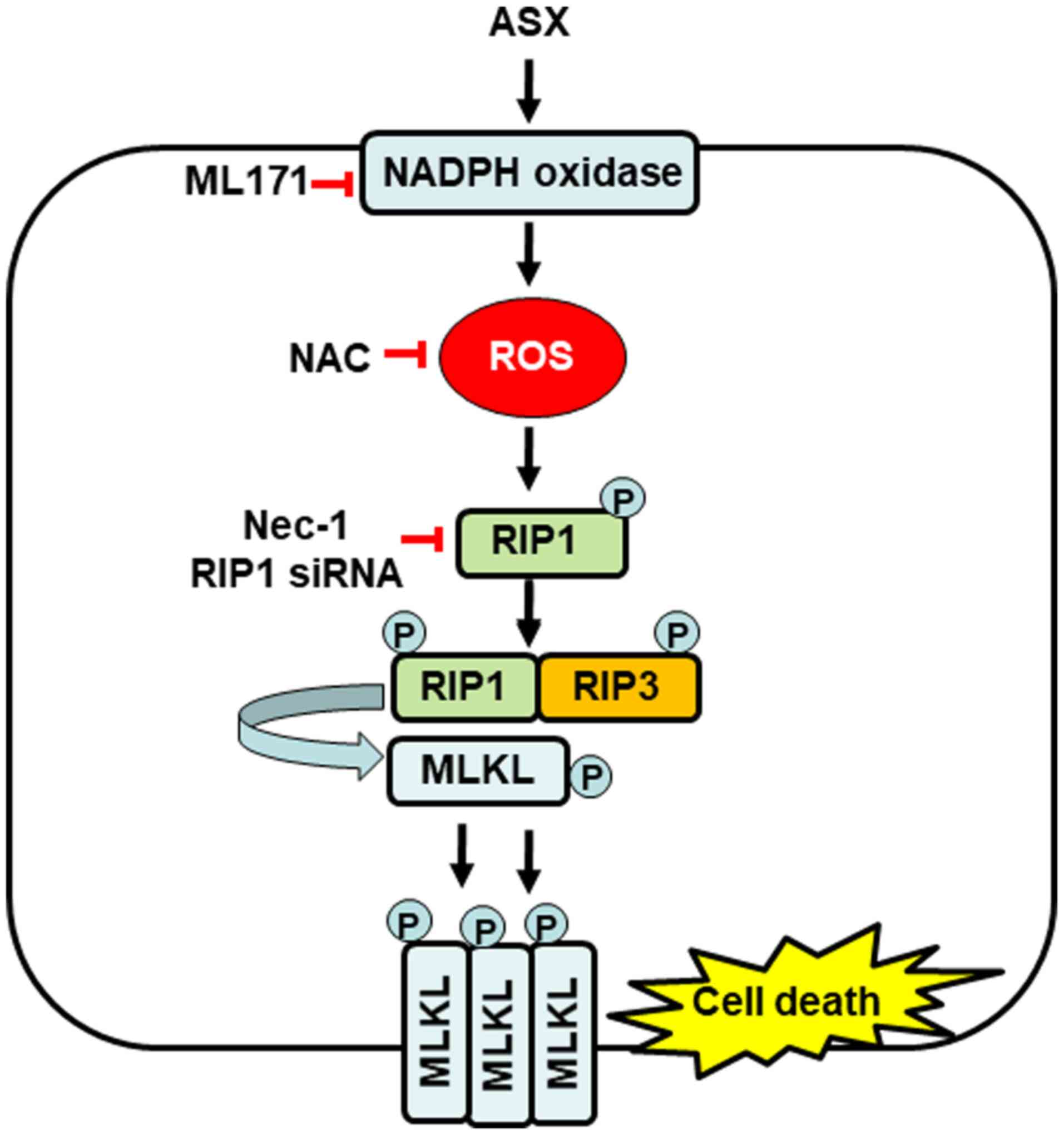|
1
|
Yamashita E: Astaxanthin as a medical
food. Funct Food Health Dis. 3:254–258. 2013. View Article : Google Scholar
|
|
2
|
Kidd P: Astaxanthin, cell membrane
nutrient with diverse clinical benefits and anti-aging potential.
Altern Med Rev. 16:355–364. 2011.PubMed/NCBI
|
|
3
|
Zhang L and Wang H: Multiple mechanisms of
anti-cancer effects exerted by astaxanthin. Mar Drugs.
13:4310–4330. 2015. View Article : Google Scholar : PubMed/NCBI
|
|
4
|
Fassett RG and Coombes JS: Astaxanthin: A
potential therapeutic agent in cardiovascular disease. Mar Drugs.
9:447–465. 2011. View Article : Google Scholar : PubMed/NCBI
|
|
5
|
Li J, Dai W, Xia Y, Chen K, Li S, Liu T,
Zhang R, Wang J, Lu W, Zhou Y, et al: Astaxanthin inhibits
proliferation and induces apoptosis of human hepatocellular
carcinoma cells via inhibition of NF-κB P65 and Wnt/B-catenin in
vitro. Mar Drugs. 13:6064–6081. 2015. View Article : Google Scholar : PubMed/NCBI
|
|
6
|
Kim JH, Park JJ, Lee BJ, Joo MK, Chun HJ,
Lee SW and Bak YT: Astaxanthin inhibits proliferation of human
gastric cancer cell lines by interrupting cell cycle progression.
Gut Liver. 10:369–374. 2016. View
Article : Google Scholar : PubMed/NCBI
|
|
7
|
Hormozi M, Ghoreishi S and Baharvand P:
Astaxanthin induces apoptosis and increases activity of antioxidant
enzymes in LS-180 cells. Artif Cells Nanomed Biotechnol.
47:891–895. 2019. View Article : Google Scholar : PubMed/NCBI
|
|
8
|
Kochi T, Shimizu M, Sumi T, Kubota M,
Shirakami Y, Tanaka T and Moriwaki H: Inhibitory effects of
astaxanthin on azoxymethane-induced colonic preneoplastic lesions
in C57/BL/KsJ-db/db mice. BMC Gastroenterol. 14:2122014. View Article : Google Scholar : PubMed/NCBI
|
|
9
|
Tanasawet S, Sukketsiri W,
Chonpathompikunlert P, Klaypradit W, Sroyraya M and Hutamekalin P:
Apoptotic effect of astaxanthin from white shrimp shells on lung
cancer A549 cells. Trop J Pharm Res. 19:1835–1842. 2020. View Article : Google Scholar
|
|
10
|
Sowmya PR, Arathi BP, Vijay K, Baskaran V
and Lakshminarayana R: Astaxanthin from shrimp efficiently
modulates oxidative stress and allied cell death progression in
MCF-7 cells treated synergistically with β-carotene and lutein from
greens. Food Chem Toxicol. 106:58–69. 2017. View Article : Google Scholar : PubMed/NCBI
|
|
11
|
Chen D, Yu J and Zhang L: Necroptosis: An
alternative cell death program defending against cancer. Biochim
Biophys Acta. 1865:228–236. 2016.PubMed/NCBI
|
|
12
|
Feng X, Song Q, Yu A, Tang H, Peng Z and
Wang X: Receptor-interacting protein kinase 3 is a predictor of
survival and plays a tumor suppressive role in colorectal cancer.
Neoplasma. 62:592–601. 2015. View Article : Google Scholar : PubMed/NCBI
|
|
13
|
He S, Liang Y, Shao F and Wang X:
Toll-like receptors activate programmed necrosis in macrophages
through a receptor-interacting kinase-3-mediated pathway. Proc Natl
Acad Sci USA. 108:20054–20059. 2011. View Article : Google Scholar : PubMed/NCBI
|
|
14
|
Ch'en IL, Tsau JS, Molkentin JD, Komatsu M
and Hedrick SM: Mechanisms of necroptosis in T cells. J Exp Med.
208:633–641. 2011. View Article : Google Scholar : PubMed/NCBI
|
|
15
|
Lu JV, Chen HC and Walsh CM: Necroptotic
signaling in adaptive and innate immunity. Semin Cell Dev Biol.
35:33–39. 2014. View Article : Google Scholar : PubMed/NCBI
|
|
16
|
Vanden Berghe T, Linkermann A,
Jouan-Lanhouet S, Walczak H and Vandenabeele P: Regulated necrosis:
The expanding network of non-apoptotic cell death pathways. Nat Rev
Mol Cell Biol. 15:135–147. 2014. View
Article : Google Scholar : PubMed/NCBI
|
|
17
|
Mifflin L, Ofengeim D and Yuan J:
Receptor-interacting protein kinase 1 (RIPK1) as a therapeutic
target. Nat Rev Drug Discov. 19:553–571. 2020. View Article : Google Scholar : PubMed/NCBI
|
|
18
|
Liu Y, Liu T, Lei T, Zhang D, Du S, Girani
L, Qi D, Lin C, Tong R and Wang Y: RIP1/RIP3-regulated necroptosis
as a target for multifaceted disease therapy (Review). Int J Mol
Med. 44:771–786. 2019.PubMed/NCBI
|
|
19
|
Lalaoui N and Brumatti G: Relevance of
necroptosis in cancer. Immunol Cell Biol. 95:137–145. 2017.
View Article : Google Scholar : PubMed/NCBI
|
|
20
|
Koo GB, Morgan MJ, Lee DG, Kim WJ, Yoon
JH, Koo JS, Kim SI, Kim SJ, Son MK, Hong SS, et al:
Methylation-dependent loss of RIP3 expression in cancer represses
programmed necrosis in response to chemotherapeutics. Cell Res.
25:707–725. 2015. View Article : Google Scholar : PubMed/NCBI
|
|
21
|
Sun W, Yu W, Shen L and Huang T: MLKL is a
potential prognostic marker in gastric cancer. Oncol Lett.
18:3830–3836. 2019.PubMed/NCBI
|
|
22
|
Zhang Y, Su SS, Zhao S, Yang Z, Zhong CQ,
Chen X, Cai Q, Yang ZH, Huang D, Wu R, et al: RIP1
autophosphorylation is promoted by mitochondrial ROS and is
essential for RIP3 recruitment into necrosome. Nat Commun.
8:143292017. View Article : Google Scholar : PubMed/NCBI
|
|
23
|
Moriwaki K and Chan FKM: RIP3: A molecular
switch for necrosis and inflammation. Genes Dev. 27:1640–1649.
2013. View Article : Google Scholar : PubMed/NCBI
|
|
24
|
Skonieczna M, Hejmo T, Poterala-Hejmo A,
Cieslar-Pobuda A and Buldak RJ: NADPH oxidases: Insights into
selected functions and mechanisms of action in cancer and stem
cells. Oxid Med Cell Longev. 2017:94205392017. View Article : Google Scholar : PubMed/NCBI
|
|
25
|
Oparka M, Walczak J, Malinska D, van Oppen
LM, Szczepanowska J, Koopman WJ and Wieckowski MR: Quantifying ROS
levels using CM-H2DCFDA and HyPer. Methods. 109:3–11. 2016.
View Article : Google Scholar : PubMed/NCBI
|
|
26
|
Livak KJ and Schmittgen TD: Analysis of
relative gene expression data using real-time quantitative PCR and
the 2(-Delta Delta C(T)) method. Methods. 25:402–408. 2001.
View Article : Google Scholar : PubMed/NCBI
|
|
27
|
Lee J, Lim JW and Kim H: Lycopene inhibits
oxidative stress-mdiated inflammatory responses in
ethanol/palmitoleic acid-stimulatd pancreatic acinar AR42J cells.
Int J Mol Sci. 22:21012021. View Article : Google Scholar : PubMed/NCBI
|
|
28
|
Minkenberg I and Ferber E:
Lucigenin-dependent chemiluminescence as a new assay for
NAD(P)H-oxidase activity in particulate fractions of human
polymorphonuclear leukocytes. J Immunol Methods. 71:61–67. 1984.
View Article : Google Scholar : PubMed/NCBI
|
|
29
|
Crowley LC, Marfell BJ and Waterhouse NJ:
Analyzing cell death by nuclear staining with Hoechst 33342. Cold
Spring Harb Protoc. Sep 1–2016.(Epub ahead of print). doi:
10.1101/pdb.prot087205. View Article : Google Scholar
|
|
30
|
Sawai H and Domae N: Discrimination
between primary necrosis and apoptosis by necrostatin-1 in Annexin
V-positive/propidium iodide-negative cells. Biochem Biophys Res
Commun. 411:569–573. 2011. View Article : Google Scholar : PubMed/NCBI
|
|
31
|
Chan FK-M, Moriwaki K and De Rosa MJ:
Detection of necrosis by release of lactate dehydrogenase activity.
Methods Mol Biol. 979:65–70. 2013. View Article : Google Scholar : PubMed/NCBI
|
|
32
|
López E, Figueroa S, Oset-Gasque MJ and
González MP: Apoptosis and necrosis: Two distinct events induced by
cadmium in cortical neurons in culture. Br J Pharmacol.
138:901–911. 2003. View Article : Google Scholar : PubMed/NCBI
|
|
33
|
Zhu K, Liang W, Ma Z, Xu D, Cao S, Lu X,
Liu N, Shan B, Qian L and Yuan J: Necroptosis promotes
cell-autonomous activation of proinflammatory cytokine gene
expression. Cell Death Dis. 9:5002018. View Article : Google Scholar : PubMed/NCBI
|
|
34
|
Yoon S, Kovalenko A, Bogdanov K and
Wallach D: MLKL, the protein that mediates necroptosis, also
regulates endosomal trafficking and extracellular vesicle
generation. Immunity. 47:51–65.e7. 2017. View Article : Google Scholar : PubMed/NCBI
|
|
35
|
Christofferson DE, Li Y, Hitomi J, Zhou W,
Upperman C, Zhu H, Gerber SA, Gygi S and Yuan J: A novel role for
RIP1 kinase in mediating TNFα production. Cell Death Dis.
3:e3202012. View Article : Google Scholar : PubMed/NCBI
|
|
36
|
McDonnell MA, Wang D, Khan SM, Vander
Heiden MG and Kelekar A: Caspase-9 is activated in a cytochrome
c-independent manner early during TNFalpha-induced apoptosis in
murine cells. Cell Death Differ. 10:1005–1015. 2003. View Article : Google Scholar : PubMed/NCBI
|
|
37
|
Dose J, Matsugo S, Yokokawa H, Koshida Y,
Okazaki S, Seidel U, Eggersdorfer M, Rimbach G and Esatbeyoglu T:
Free radical scavenging and cellular antioxidant properties of
astaxanthin. Int J Mol Sci. 17:1032016. View Article : Google Scholar : PubMed/NCBI
|
|
38
|
Kogure K: Novel Antioxidative activity of
astaxanthin and its synergistic effect with vitamin E. J Nutr Sci
Vitaminol (Tokyo). 65 (Suppl 1):S109–S112. 2019. View Article : Google Scholar : PubMed/NCBI
|
|
39
|
Landon R, Gueguen V, Petite H, Letourneur
D, Pavon-Djavid G and Anagnostou F: Impact of astaxanthin on
diabetes pathogenesis and chronic complications. Mar Drugs.
18:3572020. View Article : Google Scholar : PubMed/NCBI
|
|
40
|
Zhou Y, Baker JS, Chen X, Wang Y, Chen H,
Davison GW and Yan X: High-dose astaxanthin supplementation
suppresses antioxidant enzyme activity during moderate-intensity
swimming training in mice. Nutrients. 11:12442019. View Article : Google Scholar : PubMed/NCBI
|
|
41
|
Rastogi R, Geng X, Li F and Ding Y: NOX
activation by subunit interaction and underlying mechanisms in
disease. Front Cell Neurosci. 10:3012017. View Article : Google Scholar : PubMed/NCBI
|
|
42
|
Emanuele S, D'Anneo A, Calvaruso G,
Cernigliaro C, Giuliano M and Lauricella M: The double-edged sword
profile of redox signaling: Oxidative events as molecular switches
in the balance between cell physiology and cancer. Chem Res
Toxicol. 31:201–210. 2018. View Article : Google Scholar : PubMed/NCBI
|
|
43
|
Jia Y, Wang F, Guo Q, Li M, Wang L, Zhang
Z, Jiang S, Jin H, Chen A, Tan S, et al: Curcumol induces
RIPK1/RIPK3 complex-dependent necroptosis via JNK1/2-ROS signaling
in hepatic stellate cells. Redox Biol. 19:375–387. 2018. View Article : Google Scholar : PubMed/NCBI
|
|
44
|
Zhang DW, Shao J, Lin J, Zhang N, Lu BJ,
Lin SC, Dong MQ and Han J: RIP3, an energy metabolism regulator
that switches TNF-induced cell death from apoptosis to necrosis.
Science. 325:332–336. 2009. View Article : Google Scholar : PubMed/NCBI
|
|
45
|
Belizário J, Vieira-Cordeiro L and Enns S:
Necroptotic cell death signaling and execution pathway: Lessons
from knockout mice. Mediators Inflamm. 2015:1280762015. View Article : Google Scholar : PubMed/NCBI
|
|
46
|
Kim YS, Morgan MJ, Choksi S and Liu ZG:
TNF-induced activation of the Nox1 NADPH oxidase and its role in
the induction of necrotic cell death. Mol Cell. 26:675–687. 2007.
View Article : Google Scholar : PubMed/NCBI
|
|
47
|
Cho YS, Challa S, Moquin D, Genga R, Ray
TD, Guildford M and Chan FK: Phosphorylation-driven assembly of the
RIP1-RIP3 complex regulates programmed necrosis and virus-induced
inflammation. Cell. 137:1112–1123. 2009. View Article : Google Scholar : PubMed/NCBI
|
|
48
|
Lu B, Gong X, Wang ZQ, Ding Y, Wang C, Luo
TF, Piao MH, Meng FK, Chi GF, Luo YN, et al: Shikonin induces
glioma cell necroptosis in vitro by ROS overproduction and
promoting RIP1/RIP3 necrosome formation. Acta Pharmacol Sin.
38:1543–1553. 2017. View Article : Google Scholar : PubMed/NCBI
|
|
49
|
Zhang Y, Chen X, Gueydan C and Han J:
Plasma membrane changes during programmed cell deaths. Cell Res.
28:9–21. 2018. View Article : Google Scholar : PubMed/NCBI
|
|
50
|
Zorov DB, Juhaszova M and Sollott SJ:
Mitochondrial reactive oxygen species (ROS) and ROS-induced ROS
release. Physiol Rev. 94:909–950. 2014. View Article : Google Scholar : PubMed/NCBI
|
|
51
|
Peoples JN, Saraf A, Ghazal N, Pham TT and
Kwong JQ: Mitochondrial dysfunction and oxidative stress in heart
disease. Exp Mol Med. 51:1–13. 2019. View Article : Google Scholar : PubMed/NCBI
|
|
52
|
Tapiero H, Townsend DM and Tew KD: The
role of carotenoids in the prevention of human pathologies. Biomed
Pharmacother. 58:100–110. 2004. View Article : Google Scholar : PubMed/NCBI
|
|
53
|
Shin J, Song MH, Oh JW, Keum YS and Saini
RK: Pro-oxidant actions of carotenoids in triggering apoptosis of
cancer cells: A review of emerging evidence. Antioxidants.
9:5322020. View Article : Google Scholar : PubMed/NCBI
|
|
54
|
Rüfer CE, Moeseneder J, Briviba K,
Rechkemmer G and Bub A: Bioavailability of astaxanthin
stereoisomers from wild (Oncorhynchus spp.) and aquacultured
(Salmo salar) salmon in healthy men: A randomised,
double-blind study. Br J Nutr. 99:1048–1054. 2008. View Article : Google Scholar : PubMed/NCBI
|
|
55
|
Miyazawa T, Nakagawa K, Kimura F, Satoh A
and Miyazawa T: Plasma carotenoid concentrations before and after
supplementation with astaxanthin in middle-aged and senior
subjects. Biosci Biotechnol Biochem. 75:1856–1858. 2011. View Article : Google Scholar : PubMed/NCBI
|
|
56
|
Barati T, Haddadi M, Sadeghi F,
Muhammadnejad S, Muhammadnejad A, Heidarian R, Arjomandnejad M and
Amanpour S: AGS cell line xenograft tumor as a suitable gastric
adenocarcinoma model: Growth kinetic characterization and
immunohistochemistry analysis. Iran J Basic Med Sci. 21:678–681.
2018.PubMed/NCBI
|
|
57
|
Barranco SC, Townsend CM Jr, Casartelli C,
Macik BG, Burger NL, Boerwinkle WR and Gourley WK: Establishment
and characterization of an in vitro model system for human
adenocarcinoma of the stomach. Cancer Res. 43:1703–1709.
1983.PubMed/NCBI
|
|
58
|
Park HS, Hong NR, Ahn TS, Kim H, Jung MH
and Kim BJ: Apoptosis of AGS human gastric adenocarcinoma cells by
methanolic extract of Dictamnus. Pharmacogn Mag. 11 (Suppl
2):S329–S336. 2015. View Article : Google Scholar : PubMed/NCBI
|
|
59
|
Tsai CL, Chiu YM, Ho TY, Hsieh CT, Shieh
DC, Lee YJ, Tsay GJ and Wu YY: Gallic Acid induces apoptosis in
human gastric adenocarcinoma cells. Anticancer Res. 38:2057–2067.
2018.PubMed/NCBI
|
|
60
|
Ngabire D, Seong YA, Patil MP,
Niyonizigiye I, Seo YB and Kim GD: Induction of apoptosis and G1
phase cell cycle arrest by Aster incisus in AGS gastric
adenocarcinoma cells. Int J Oncol. 53:2300–2308. 2018.PubMed/NCBI
|
|
61
|
Zhu Z, Wang Y, Zhang C, Yu S, Zhu Q, Hou K
and Yan B: TRIM25 blockade by RNA interference inhibited migration
and invasion of gastric cancer cells through TGF-β signaling. Sci
Rep. 6:190702016. View Article : Google Scholar : PubMed/NCBI
|
|
62
|
Li X, Zhang X, Liu X, Tan Z, Yang C, Ding
X, Hu X, Zhou J, Xiang S, Zhou C, et al: Caudatin induces cell
apoptosis in gastric cancer cells through modulation of
Wnt/β-catenin signaling. Oncol Rep. 30:677–684. 2013. View Article : Google Scholar : PubMed/NCBI
|
|
63
|
Zhou C, Li X, Zhang X, Liu X, Tan Z, Yang
C and Zhang J: microRNA-372 maintains oncogene characteristics by
targeting TNFAIP1 and affects NFκB signaling in human gastric
carcinoma cells. Int J Oncol. 42:635–642. 2013. View Article : Google Scholar : PubMed/NCBI
|
|
64
|
Guan SS, Chang J, Cheng CC, Luo TY, Ho AS,
Wang CC, Wu CT and Liu SH: Afatinib and its encapsulated polymeric
micelles inhibits HER2-overexpressed colorectal tumor cell growth
in vitro and in vivo. Oncotarget. 5:4868–4880. 2014. View Article : Google Scholar : PubMed/NCBI
|
|
65
|
Lim JY, Kim D, Kim BR, Jun JS, Yeom JS,
Park JS, Seo JH, Park CH, Woo HO, Youn HS, et al: Vitamin C induces
apoptosis in AGS cells via production of ROS of mitochondria. Oncol
Lett. 12:4270–4276. 2016. View Article : Google Scholar : PubMed/NCBI
|
|
66
|
Sheng YN, Luo YH, Liu SB, Xu WT, Zhang Y,
Zhang T, Xue H, Zuo WB, Li YN, Wang CY, et al: Zeaxanthin induces
apoptosis via ROS-regulated MAPK and AKT signaling pathway in human
gastric cancer cells. OncoTargets Ther. 13:10995–11006. 2020.
View Article : Google Scholar : PubMed/NCBI
|
|
67
|
Park Y, Choi J, Lim JW and Kim H:
β-Carotene-induced apoptosis is mediated with loss of Ku proteins
in gastric cancer AGS cells. Genes Nutr. 10:4672015. View Article : Google Scholar : PubMed/NCBI
|
|
68
|
Dong W, Li Z, Chen Y, Zhang L, Ye Z, Liang
H, Li R, Xu L, Zhang B, Liu S, et al: NADPH oxidase inhibitor,
diphenyleneiodonium prevents necroptosis in HK-2 cells. Biomed Rep.
7:226–230. 2017. View Article : Google Scholar : PubMed/NCBI
|
|
69
|
Tian Q, Qin B, Gu Y, Zhou L, Chen S, Zhang
S, Zhang S, Han Q, Liu Y and Wu X: ROS-mediated necroptosis is
involved in iron overload-induced osteoblastic cell death. Oxid Med
Cell Longev. 2020:12953822020. View Article : Google Scholar : PubMed/NCBI
|
|
70
|
Deragon MA, McCaig WD, Patel PS, Haluska
RJ, Hodges AL, Sosunov SA, Murphy MP, Ten VS and LaRocca TJ:
Mitochondrial ROS prime the hyperglycemic shift from apoptosis to
necroptosis. Cell Death Discov. 6:1322020. View Article : Google Scholar : PubMed/NCBI
|



















